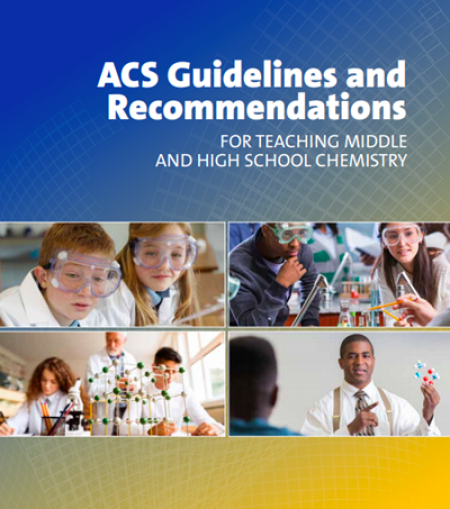High School Core Concepts
The following tables outline the core ideas in chemistry that should be addressed in any comprehensive high school curriculum. Each core idea is further broken into chemical principles, and suggested concepts to teach within those ideas are listed. These tables have been generated with the guidance of the Next Generation Science Standards (NGSS) performance expectations (PEs) and disciplinary core ideas (DCIs). The task force identified the concepts that fall into each DCI within the core ideas.
The content does not need to be learned or shared in the order presented, and this is not an all-inclusive list. For example, there are PEs and DCIs within the Earth & Space Sciences (ESS) as well as the Engineering, Technology & Applications of Science (ETS) standards that could be learned by students within a physical science or chemistry course. (For example, Global Climate Change is a DCI within ESS and could easily be addressed in a physical science or chemistry curriculum.) These tables emphasize only concepts found within the Physical Science PEs in NGSS. Teachers may have additional standards (such as the Common Core State Standards in English Language Arts & Mathematics) that they need to incorporate into their teaching practice. Teachers also may need to consult state and local standards to ensure all of the essential elements and assessment boundaries of their curriculum are included.
Core Concepts of Chemistry
- Matter and Its Interactions
- Motion and Stability
- Energy
- Waves
Matter and Its Interactions
Chemical Principles (DCIs)
- Structure and properties of matter
- Chemical reactions
- Nuclear processes
Chemistry Concepts
- States of matter
- Solutions
- Periodicity
- Bonding and intermolecular forces
- Physical changes
- Chemical changes
- Reaction types
- Stoichiometry
- Kinetics
- Equilibrium
- Nuclear chemistry
Motion and Stability: Forces and Interactions
Chemical Principles (DCIs)
- Structure and properties of matter
- Forces and motion
- Types of interactions
- Definitions of energy
Chemistry Concepts
- Periodicity and atomic structure
- Bonding and intermolecular forces
- Ionic bonding
- Covalent bonding
- Molecular structure
- Types of chemical reactions
- Kinetics
- Electrochemistry
- Materials: properties explained by molecular structure
- Chemical engineering
Energy
Chemical Principles (DCIs)
- Definitions of energy
- Conservation of energy and energy transfer
- Relationship between energy and forces
- Energy in chemical processes
Chemistry Concepts
- Thermochemistry
- Thermodynamics
- Equilibrium
- Bonding and intermolecular forces
- Electrochemistry
- Nuclear chemistry
- Nature of science
- Chemical engineering
- Thermodynamics
Waves and Electromagnetic Radiation
Chemical Principles (DCIs)
- Energy in chemical processes
- Wave properties
- Electromagnetic radiation
- Information technologies and instrumentation
Chemistry Concepts
- Atomic structure
- Electromagnetic radiation spectrum
- Quantitative analysis (e.g., Beer’s law)
ACS Guidelines and Recommendations
for Teaching Middle and High School Chemistry
An essential resource for middle and high school physical science and chemistry teachers, curriculum developers, principals, and other school administrators who support teachers in those roles.
Learn about the nature of instruction, the core ideas to teach, the physical instructional environment, safety, sustainability, and the professional responsibilities of teachers.


